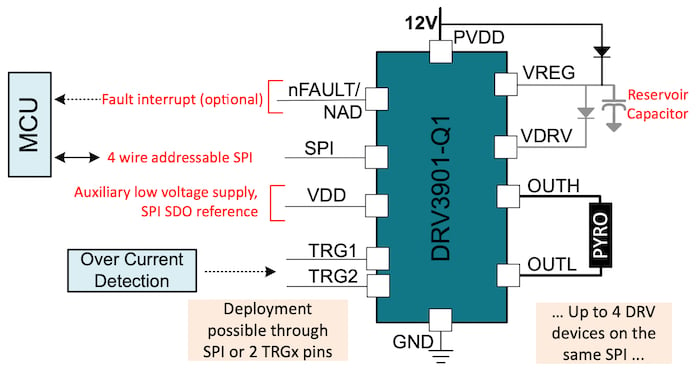TI Streamlines ADAS and EV Development with Integrated Sensing and Power Management Solutions in a Single Chip
During CES this week, Texas Instruments (TI) showcased a collection
of innovative single-chip solutions for the automotive sector,
prominently featuring the industry's initial automotive radar sensor
designed for satellite architectures.
At this year's Consumer
Electronics Show (CES 2024), TI introduced a suite of new automotive
products poised to simplify intricate systems by consolidating them into
individual chip solutions. These cutting-edge chips from TI are set to
provide a standardized solution tailored for designers who are
simultaneously prioritizing vehicle performance and compliance with
safety regulations. Visitors can experience these advancements firsthand
at TI's CES exhibition.
The fresh line-up of automotive chips from TI is engineered to enhance satellite sensing and power management functionalities.

The latest automotive chips from TI
target satellite sensing and power management, allowing vehicles to
become smarter and safer using single-chip solutions.
Although
the mass-market deployment of fully autonomous vehicles remains on the
horizon, Original Equipment Manufacturers (OEMs) are making strides in
refining sensor technology and Battery Management Systems (BMS) for
enhanced driver-assist functionality. Radar sensors and power management
subsystems that are ready for commercial use, such as those recently
introduced by Texas Instruments (TI), provide designers with the
advantage of focusing on innovation and adding new features rather than
reallocating time to update existing designs to conform to evolving
industry standards.
Enhancing ADAS with Extended Range Satellite Radar
For
advanced driver-assistance systems (ADAS) to effectively enhance
vehicle safety and operation, they rely on accurately sensing the
environment and making informed decisions. This sensory perception is
traditionally achieved through an amalgamation of radar and camera
sensors. Each radar sensor is responsible for an intensive level of data
processing, after which it communicates the processed information to an
ADAS electronic control unit (ECU).
Adopting a satellite-based
approach can elevate performance by taking advantage of current
high-speed processing capabilities. This method involves conducting
preliminary processing of the sensor data and then transmitting it to a
central ECU. Here, by integrating data from all sensors, sophisticated
ADAS and sensor fusion algorithms can process the information, resulting
in superior performance. This centralized processing strategy allows
for a more comprehensive interpretation of the sensor data, contributing
to more accurate and reliable vehicle assistance systems.

The AWR2544EVM highlights the benefits of LOP and custom waveguide antennas (left), both of which improve directivity and range in what is normally a limited antenna system.
Much like previous generations of TI mmWave radars, the AWR2544 radar sensor (datasheet linked) includes a 5-GHz bandwidth with 8 total RF ports (4 TX 4 RX). Furthermore, the AWR2544 includes Launch-on-Package (LOP) support, where waveguide antennas can be directly mounted on the PCB to boost performance and maximum range using custom 3D antennas.
Single-Chip BMS Solutions
While radar sensors can preserve safety from outside threats, power management systems prevent catastrophic events caused by shorts. Among these systems, contactor (or relay) drivers and pyro-fuse drivers are critical for safety and efficiency.
In addition to AWR2544 radar sensor, TI has also announced the DRV3901-Q1 pyro-fuse driver and DRV3946-Q1 contactor driver to simplify vehicle power system development.

Battery management leverages contactors and fuses to remove power as needed.
The DRV3901 (datasheet linked) can efficiently control pyro-fuses to ensure faster blow times than melting fuses. It also constantly monitors the backup power capacitors to ensure that the pyro-fuses can still blow even after a power-loss event.

Simplified schematic of the DRV3901.
TI's second driver in this release, the DRV3946 (datasheet linked), efficiently drives contactors to connect or disconnect power from vehicle subsystems such as interior lights or heaters. This chip is designed to replace legacy economizers and offers a high degree of control to maintain efficiency. Programmable peak and hold currents ensure that the contactors can turn on/off quickly and safely without wasting power.

Simplified schematic of the DRV3946.
All three automotive chips—the AWR2544EVM radar sensor, DRV3901-Q1 pyro-fuse driver, and DRV3946-Q1 contactor driver—are available in preproduction quantities along with evaluation modules. TI will offer system-level demonstrations of these chips at CES 2024, highlighting how ADAS and BMS designs can benefit from them.
Simplifying System Design
While these chips from TI may not directly add new functionality to vehicle systems, the benefits of single-chip solutions could allow designers to focus less on qualifying custom designs and more on developing novel applications using the latest automotive processors. As a result, the chips may be used in new vehicle architectures to improve driver safety, vehicle response, and autonomy levels of next-gen EVs.
TI is exhibiting at CES 2024 this week. Visit them at North Hall meeting rooms N115, N116, N117, and N118 in the Las Vegas Convention Center.
All images used courtesy of Texas Instruments







